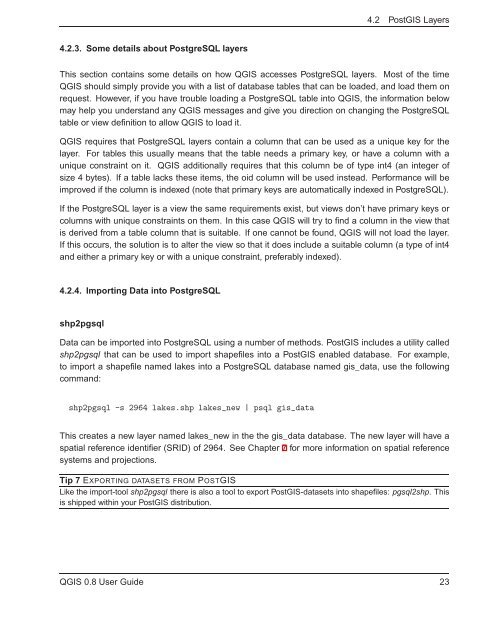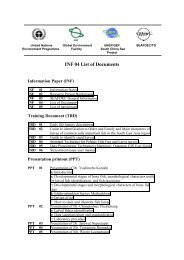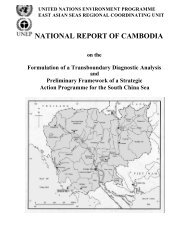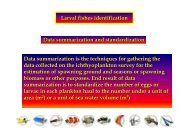TRD 05: Data Presentation techniques (Mapping) Quantum GIS ...
TRD 05: Data Presentation techniques (Mapping) Quantum GIS ...
TRD 05: Data Presentation techniques (Mapping) Quantum GIS ...
You also want an ePaper? Increase the reach of your titles
YUMPU automatically turns print PDFs into web optimized ePapers that Google loves.
4.2 Post<strong>GIS</strong> Layers<br />
4.2.3. Some details about PostgreSQL layers<br />
This section contains some details on how Q<strong>GIS</strong> accesses PostgreSQL layers. Most of the time<br />
Q<strong>GIS</strong> should simply provide you with a list of database tables that can be loaded, and load them on<br />
request. However, if you have trouble loading a PostgreSQL table into Q<strong>GIS</strong>, the information below<br />
may help you understand any Q<strong>GIS</strong> messages and give you direction on changing the PostgreSQL<br />
table or view definition to allow Q<strong>GIS</strong> to load it.<br />
Q<strong>GIS</strong> requires that PostgreSQL layers contain a column that can be used as a unique key for the<br />
layer. For tables this usually means that the table needs a primary key, or have a column with a<br />
unique constraint on it. Q<strong>GIS</strong> additionally requires that this column be of type int4 (an integer of<br />
size 4 bytes). If a table lacks these items, the oid column will be used instead. Performance will be<br />
improved if the column is indexed (note that primary keys are automatically indexed in PostgreSQL).<br />
If the PostgreSQL layer is a view the same requirements exist, but views don’t have primary keys or<br />
columns with unique constraints on them. In this case Q<strong>GIS</strong> will try to find a column in the view that<br />
is derived from a table column that is suitable. If one cannot be found, Q<strong>GIS</strong> will not load the layer.<br />
If this occurs, the solution is to alter the view so that it does include a suitable column (a type of int4<br />
and either a primary key or with a unique constraint, preferably indexed).<br />
4.2.4. Importing <strong>Data</strong> into PostgreSQL<br />
shp2pgsql<br />
<strong>Data</strong> can be imported into PostgreSQL using a number of methods. Post<strong>GIS</strong> includes a utility called<br />
shp2pgsql that can be used to import shapefiles into a Post<strong>GIS</strong> enabled database. For example,<br />
to import a shapefile named lakes into a PostgreSQL database named gis_data, use the following<br />
command:<br />
shp2pgsql -s 2964 lakes.shp lakes_new | psql gis_data<br />
This creates a new layer named lakes_new in the the gis_data database. The new layer will have a<br />
spatial reference identifier (SRID) of 2964. See Chapter 7 for more information on spatial reference<br />
systems and projections.<br />
Tip 7 EXPORTING DATASETS FROM POST<strong>GIS</strong><br />
Like the import-tool shp2pgsql there is also a tool to export Post<strong>GIS</strong>-datasets into shapefiles: pgsql2shp. This<br />
is shipped within your Post<strong>GIS</strong> distribution.<br />
Q<strong>GIS</strong> 0.8 User Guide 23
















